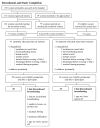Postnatal unit bassinet types when rooming-in after cesarean birth: implications for breastfeeding and infant safety
- PMID: 22914755
- PMCID: PMC3746007
- DOI: 10.1177/0890334412452932
Postnatal unit bassinet types when rooming-in after cesarean birth: implications for breastfeeding and infant safety
Abstract
Background: Postnatal unit rooming-in promotes breastfeeding. Previous research indicates that side-cars (3-sided bassinets that lock onto the maternal bed frame) facilitate breastfeeding after vaginal birth more than stand-alone bassinets (standard rooming-in). No study has previously investigated side-car bassinet use after cesarean, despite the constraints on maternal-infant interactions that are inherent in recovery from this birth mode.
Objective: To test the effect of the side-car bassinet on postnatal unit breastfeeding frequency and other maternal-infant behaviors compared to a stand-alone bassinet following cesarean birth.
Methods: Participants were recruited and prenatally randomized to receive the side-car or stand-alone bassinet for their postnatal unit stay between January 2007 and March 2009 in northeastern England. Mother-infant interactions were filmed over the second postpartum night. Participants completed face-to-face interviews before and after filming. The main outcome measures were infant location, bassinet acceptability, and breastfeeding frequency. Other outcomes assessed were breastfeeding effort, maternal-infant contact, sleep states, midwife presence, and infant risk.
Results: Differences in breastfeeding frequency, maternal-infant sleep overlap, and midwife presence were not statistically significant. The 20 dyads allocated to side-car bassinets breastfed a median of 0.6 bouts/ hour compared to 0.4 bouts/hour for the 15 stand-alone bassinet dyads. Participants expressed overwhelming preference for the side-car bassinets. Bed sharing was equivalent between the groups, although the motivation for this practice may have differed. Infant handling was compromised with stand-alone bassinet use, including infants positioned on pillows while bed sharing with their sleeping mothers.
Conclusions: Women preferred the side-car, but differences in breastfeeding frequency were not statistically significant. More infant risks were observed with stand-alone bassinet use.
Conflict of interest statement
The authors declare that they have no potential conflicts of interest with respect to the research, authorship, and/or publication of this article.
Figures
References
-
- Chertok IR. Breast-feeding initiation among post-caesarean women of the Negev, Israel. Br J Nurs. 2006;15(4):205–208. - PubMed
-
- Declercq E, Cunningham DK, Johnson C, Sakala C. Mothers’ reports of postpartum pain associated with vaginal and cesarean deliveries: Results of a national survey. Birth. 2008;35(1):16–24. - PubMed
-
- Karlström A, Engström-Olofsson R, Norbergh K-G, Sjöling M, Hildingsson I. Postoperative pain after cesarean birth affects breastfeeding and infant care. J Obstet Gynecol Neonatal Nurs. 2007;36(5):430–440. - PubMed
-
- Betrán AP, Merialdi M, Lauer JA, et al. Rates of caesarean section: Analysis of global, regional and national estimates. Paediatr Perinat Epidemiol. 2007;21(2):98–113. - PubMed
-
- Declercq E, Young R, Cabral H, Ecker J. Is a rising cesarean delivery rate inevitable? Trends in industralized countries, 1987 to 2007. Birth. 2011;38(2):99–104. - PubMed
Publication types
MeSH terms
Grants and funding
LinkOut - more resources
Full Text Sources
Other Literature Sources
Medical



